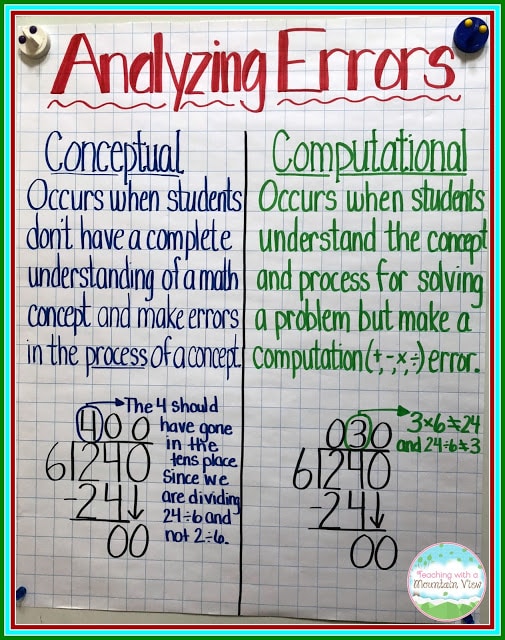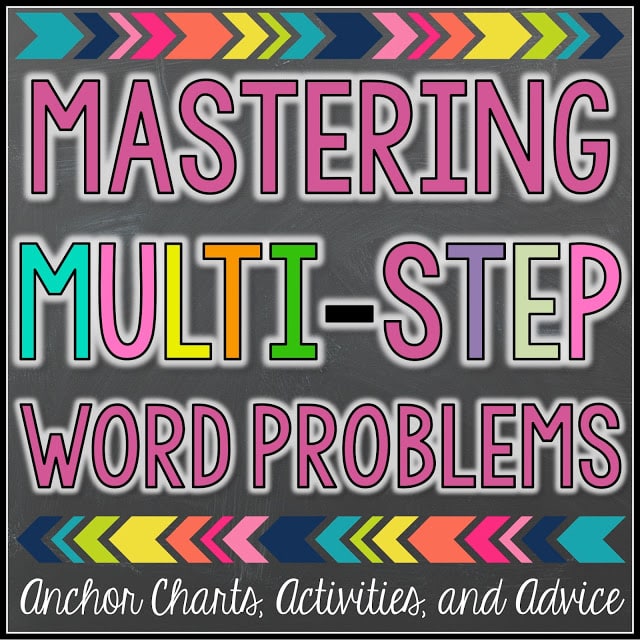Teaching Precise Math Vocabulary
By Mary Montero
Share This Post:
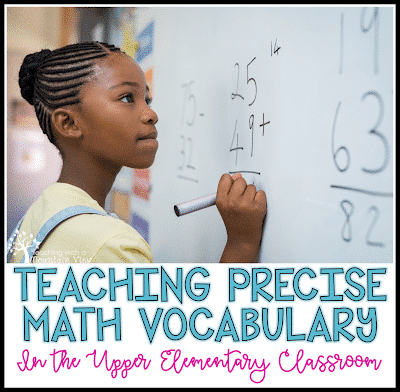
A few years ago, I was heavily pregnant, and my students were scheduled to go on a field trip three hours away from the school. Since I was so close to my due date (and we all know how school buses are…), we decided it would be best if the interventionist and I swapped duties for the day. As she was going through her schedule with me, she made a quick aside.
“Make sure they say 5 plus 5 EQUALS 10, and not 5 plus 5 is ten,” she reminded me before quickly apologizing with an abrupt, “I know you know that. Sorry.” It gave me pause because, while I did, in fact, know that many educators believe this to be best practice, it occurred to me that I rarely put this into action in my own classroom. It was just the reminder I needed about the importance of math vocabulary and just how critical it is to use formal math vocabulary as much as possible during everyday conversation with my students…and encourage them to do the same.
I know I’ve seen it said that using math vocabulary isn’t crucial to student success- some opponents even argue that it is confusing for kids and adds an extra degree of difficulty to math tasks. However, I truly believe that encouraging students to use correct, precise math vocabulary increases their comprehension and ability to tackle math word problems, improves performance on standardized tests (which almost always use proper, precise math vocabulary), and gives every child a little boost as they progress through the grade levels.

Teaching Precise Math Vocabulary The Upper Elementary Classroom
While it takes a bit of extra time to incorporate this vocabulary as you are teaching concepts, my students love it when they sound like official mathematicians! I do a lot of pre-teaching to explain that while some of the more informal terms aren’t always inaccurate and certainly not wrong, it’s so much more impressive to use formal math terms. Also explain to them that it will help them in the long run and helps them better understand math concepts. I make a big deal out of it (you don’t usually learn this until 6th grade, but we’re tackling it today, because I know you can handle it). They eat it up!
Here are a few ways that I encourage my students to routinely infuse formal math vocabulary in the classroom, and a few terms that I’m a particular stickler about with my students. You can also download this free guide with more tips and practice activities!
Expression, Equation, Number Sentence
I’ll admit that I previously used these terms interchangeably, just hoping my students would recognize them when it came time for testing season. I know there are still anchor charts on my blog that use the terms incorrectly, and I cringe every time I see one (note to self: fix that!). Eventually, though, I decided I needed to explicitly teach these terms to my 4th and 5th graders, and they did an amazing job! Here’s a sample anchor chart to teach students the difference between an expression and an equation.
You’ll notice that “Express” is underlined under Expression and “Equa” is underlined under Equation. Expressions are short, hence the “express” and “equa” is similar to equal. This helps my students remember the difference.
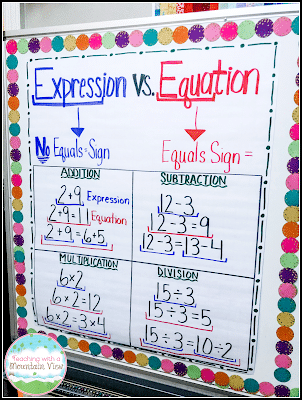
Decimal Points
If you were to ask my former students what I’m MOST picky about when it comes to math talk, this would probably be it.
1.24 is not one point two four or one point twenty-four.
Well, technically, it is, but my students know they need “permission to use point,” which is granted only in specific (and usually hurried) situations.
1.24 is one and twenty-four hundredths.
Reading Whole Numbers
Along the same lines as the decimals points, I am hyper picky about students not adding “and” when they are reading whole numbers. 105 is not one hundred and five, just one hundred five. “And” is reserved only for decimals, even with my young students who don’t know how to read decimals yet.
Reading Fractions
If I student reads 1/4 as one over four, I usually ask them to rephrase it to either one fourth or a quarter.
If a student tells me the “top number” of a fraction is one, I ask them to rephrase it to, “the numerator” is one. Same goes if they tell me the “bottom number” of a fraction is four. They rephrase it to “the denominator” is four.
Greater Than > and Less Than <
So often I hear kids say, “The arrow is pointing at the smaller number!” or “The alligator is eating the smaller number.” I know these are all techniques we use to teach young students how to use the symbols, but as they get older, it’s so important that they can read an expression like 456 > 87 as “456 is greater than 87.”
Regroup and Decompose
I know this one is controversial, but they aren’t borrowing any numbers, they are regrouping the numbers. This definitely causes a bit of a generational divide, as I grew up with the term borrowing and carrying, as did most of our students’ parents. However, if we are really focusing on using math vocabulary to help our students understand the math concepts, they will learn to understand what “regrouping” and “decomposing” mean just as we understood the function of “borrow” and “carry.” The only difference is that as they get older, they will understand that these terms are literal (and they are great for mini lessons on prefixes, too!)
Improper Fraction and Fraction Greater than One
I’m going to admit that I’m still not completely fluent with this change, but did you know that the more up-to-date and accurate term for an improper fraction is a “fraction greater than one?” It’s literal, and it’s a great teaching moment. Since “improper fraction” is still used regularly in textbooks and other resources, I teach both terms and use them interchangeably.
Reduced and Simplified Fractions
This one is very similar to the one above. I still use both terms interchangeably and make sure that my students understand that we really aren’t reducing the fraction or making it smaller, but putting it into its simplest form.
Geometry Terms
Those aren’t corners. Those are vertices. 🙂
Dimensions (Area & Perimeter)
I can’t tell you how many times I’ve had students get to me in 4th grade and have a good grasp on perimeter and area concepts but have no idea what a dimension is or how to read dimensions (ie. 4 x 3 is four by three or length times width). This is an easy, easy fix, and there’s something that kids love about the word dimension.
Along the same lines, I tend to always refer to the “outside” of a shape as the perimeter of it and the inside of it as the area.
Operations
I constantly ask my students, “What operation did you use to solve this problem?”
I have also stopped saying, “What’s the answer?” whenever possible and replaced that with, “What’s the sum/difference/product/quotient?” anywhere that I can.
Digits
This is another important one. There are three DIGITS in the number 453. It’s so important that students understand the difference between the digits and the number, just like they understand that letters are different than words.
Attending to Precision with Informal vs. Formal Math Talk
I want to emphasize that I don’t call my students out as wrong or tell them that the more informal terms are inaccurate (unless they are). To me, having my students practice their math vocabulary during conversations and math discussions is just like having them practice their reading fluency, and it becomes just that– fluent.
Do you teach the Standards of Mathematical Practice in your classroom? If so, you’ll recognize that this all really comes down to the Mathematical Practice of attending to precision. When students say, “To solve this problem, I did take away,” I think it’s completely reasonable to ask them to be more precise with their language and say, “To solve this problem, I subtracted…”
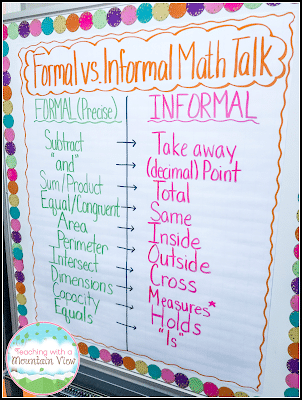
What are you a stickler for when it comes to math vocabulary?
A special note: Please note that I have used these strategies and expectations with all students, but students needing extra support or English Language Learners may need additional scaffolds, support, and accommodations.
Formal vs. Informal Math Talk Anchor Chart Inspiration:
Building a Bridge to Academic Math Vocabulary
Other Math Posts You May Enjoy
Mary Montero
I’m so glad you are here. I’m a current gifted and talented teacher in a small town in Colorado, and I’ve been in education since 2009. My passion (other than my family and cookies) is for making teachers’ lives easier and classrooms more engaging.







